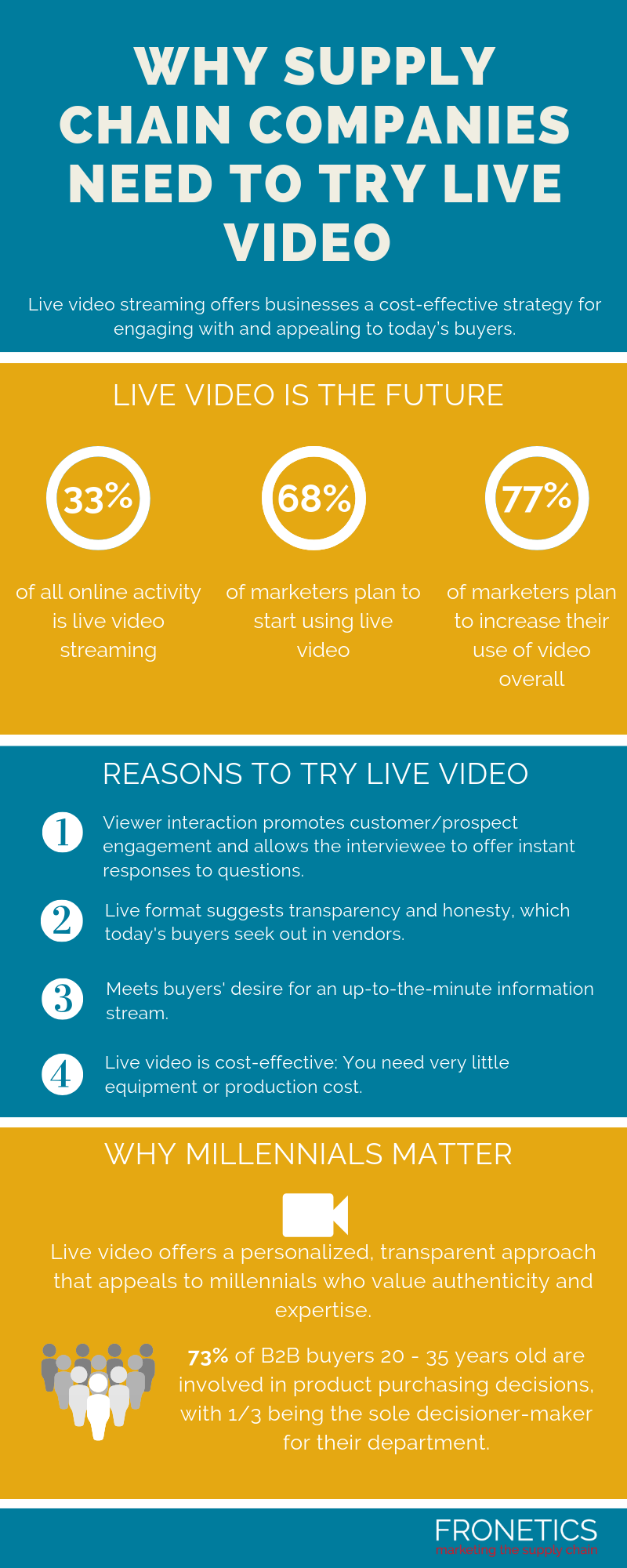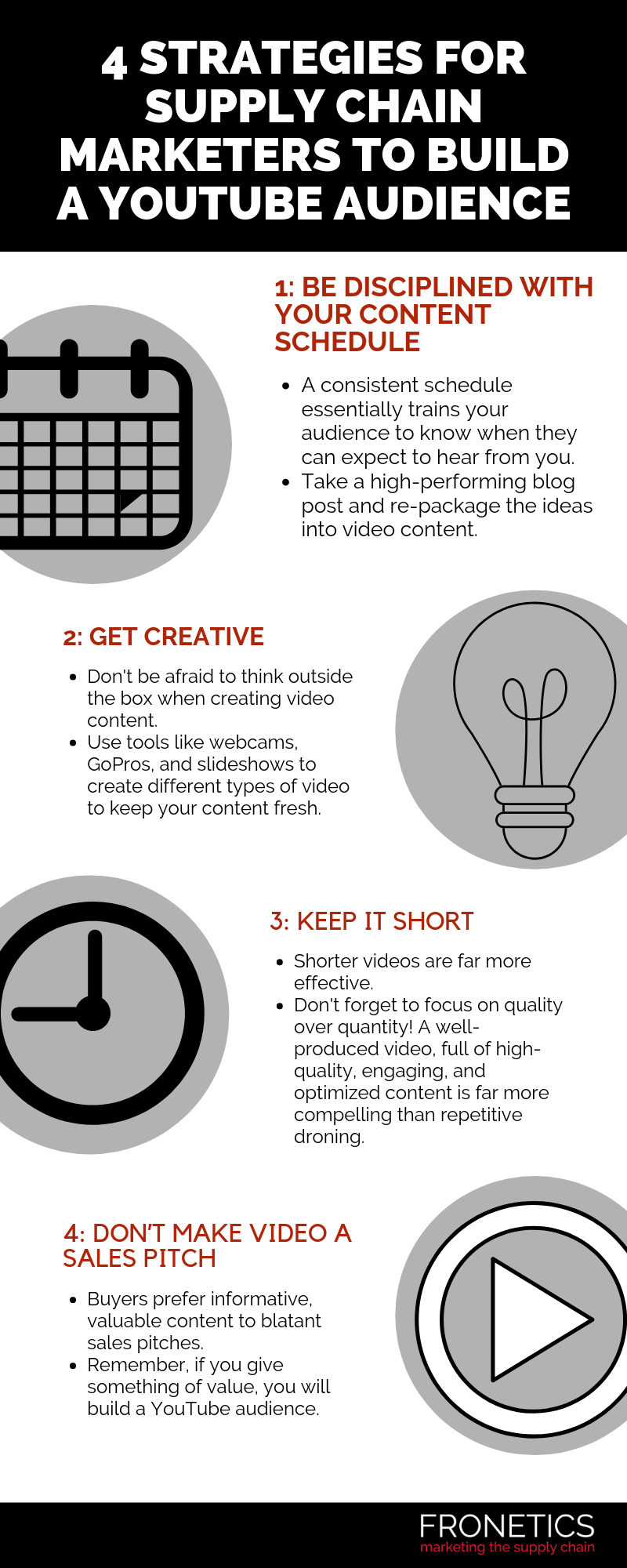
by Fronetics | Sep 18, 2019 | Blog, Marketing, Social Media, Video Marketing
Here are 15 social video marketing statistics that every supply chain marketer should be aware of in 2019.
Highlights:
- 87% of business use video as a marketing tool.
- 83% of marketers report that video gives them a good ROI.
- Social video marketing trends to be on the lookout for: live video and 1:1 personalized video.
If you believe everything you read, you might think that social video marketing has taken a bit of a hit in the past year or so. Largely thanks to Facebook’s well-publicized inflation of video view metrics, companies are naturally wary of investing in video creation and promotion on the platform.
But Facebook’s transgressions shouldn’t undermine marketers’ confidence in the future of social video marketing. Both expert analysis and hard numbers support the notion that video isn’t going anywhere. As digital media expert Michael Humphrey puts it, “All the major upward trends still wrap around video.”
According to Lux Narayan, CEO of independent social analytics company Unmetric, audiences “are longing for more interactive experiences as well as long-form storytelling that only video can best achieve.”
Here are 15 social video marketing statistics we think supply chain marketers should be aware of.
15 social video marketing statistics for 2019
- 47% of internet users have watched brand advertising videos on social media within the past 3 months. (Toluna)
- Of the social media users who have watched branded videos in the past 3 months, 43% watched on Facebook, 38% on YouTube, 18% on Instagram, and 13% on Twitter. (Toluna)
- 87% of businesses now use video as a marketing tool, up from 63% in 2017. (Wyzowl)
- 55% of people consume videos thoroughly – the highest percentage of any content type. (HubSpot)
- 30% of users prefer video ads to text or still image ads, while 52% report having no preference. (Only 18% prefer text or still image ads). (Toluna)
- 83%of marketers say video gives them a good ROI, up from 78% in 2018. (Wyzowl)
- 52% of consumers say that watching product videos makes them more confident in online purchase decisions. (Invodo)
- 68%of people say they’d most prefer to learn about a new product or service by watching a short video, over text-based articles (15%), infographics (4%), presentations and pitches (4%), and ebooks and manuals (3%). (Wyzowl)
- 48% of social media users have sought more information about a product or service based on social video marketing. (Toluna)
- 33% of survey respondents answered yes to having bought a product or service from a brand solely based on social video marketing. (Toluna)
- 88% of video marketers are satisfied with the ROI of their video marketing efforts on social media. (Animoto)
- 82% of social media users prefer live video from a brand to social posts. (Impact)
- 81% of marketers say video has helped them generate leads, and 84% say video has helped them increase traffic to their website. (Wyzowl)
- 61% of marketers have made more marketing videos in house in 2018 than they did in 2017. (Animoto)
- 67% of users said they would like to see more social video marketing in the future over other types of ads. The remaining 33% are indifferent, not opposed. (Toluna)
The future of social video marketing
Suffice it to say, the numbers bear out the fact that video marketing, and particularly social video marketing, is a trend that’s here to stay. Live video is increasingly popular, and savvy brands are incorporating it into their strategies.
In addition to live video, given the growing ease of shooting video on smartphones, another big trend is likely to be 1:1 video. Marketers can nurture leads via personalized video messages, rather than phone calls or emails, using video to offer additional content, product support, or simply to foster a relationship.
The bottom line is that video offers up the kind of engaging storytelling that users today want. And social media is the ideal distribution platform for video, making social video marketing a winning strategy.
Related links:


by Elizabeth Hines | Sep 12, 2019 | Blog, Content Marketing, Marketing, Social Media, Video Marketing
Live video streaming offers businesses a cost-effective strategy for engaging with and appealing to today’s buyers.
With YouTube emerging as the world’s second largest search engine and video becoming themost popular form of online content,it is no surprise that businesses are looking for ways to engage their target audience through video. And they’re even diving into a growing trend in video marketing: publishing content in real time. It makes sense, given live video streaming now represents 33% of all online activity.
Live video was used more for niche markets in its early days. But 68% of marketers plan to start using live video in the next year, and 77% of marketers plan to increase their use of video overall.

(Made with Canva)
How can live video work for the supply chain?
Live video is an increasingly popular content medium for the millennial generation, which is important for supply chain marketers to note as the B2B purchasing landscape skews younger. Consider that around 73% of 20 to 35 year olds are involved in product purchasing decisions at their companies, with one-third reporting being the sole decision-maker for their department. And a 2015 Google/Millward Brown survey of buyers found that about half of purchasing researchers were between the ages of 18 and 24 — and that percentage has only grown in the last few years.
Another important trait to note about millennials? They’re immediately turned off by overt sales pitches. Instead, they expect vendors to offer them value outside the sales funnel by way of education, entertainment, inspiration, or knowledge. So instead of creating video content to promote products, supply chain companies should use the opportunity to provide viewers with these elements of value they expect.
Live video streaming is the ideal medium for doing so, as it offers the transparency, emotion, and personal elements millennial buyers desire. Vendors can connect with buyers on an emotional level while simultaneously communicating their companies’ expertise, which directly impacts the buyers’ opinions of their solutions.
4 reasons to try live video streaming
Live video streaming offers real benefits for supply chain companies in addition to the increasing opportunity to connect with prospective buyers. When clients ask about whether they should try live video, I give them these four reasons:
1. Earn customer/prospect engagement and feedback
Most live video platforms have features that allow for viewer interaction, meaning customers and prospects can ask you questions and get instant responses. (Talk about excellent customer service!) That generates a positive experience that strengthens their relationship with your company. Also, you get the benefit of hearing feedback from a portion of your audience, which you can use to drive change and growth.
2. Promote transparency
Live video can be unpredictable, raw, and honest — which, admittedly, can be scary for the person filming. But today’s buyers crave this kind of transparency. When you go live, things may not always go as planned, but that will work in your favor more often than not.
3. Appeal to those who love to be in-the-minute
Social media users love to feel on top of their information streams. Live video offers that sense of insider, up-to-the-minute scoop that appeals to them.
4. Publish video in a cost-effective way
High-production videos can be costly and can take weeks to produce. One of the best parts about live video is that you need only a smart phone, a Wi-Fi connection, and someone willing to appear on camera (which is sometimes harder than it sounds). Publishing happens in real time, and then most platforms allow you to archive the footage for viewers to access later.
The takeaway
We’ve seen clients have great success with live video streaming. It’s one of those trends that’s not going away anytime soon. In fact, social platforms are increasingly adding “live” and “Stories-like” features to satisfy users’ seemingly insatiable appetite for this format.
That means if you haven’t tried live video, you should think about it. Pretty soon you’ll be one of the only ones among your competitors who is not — if you’re not already.
This post originally appeared on EBN Online.
Related posts:


by Fronetics | Jul 23, 2019 | Blog, Marketing, Social Media, Video Marketing
Videos drive greater conversion rates and increased leads. Here are four takeaways from Vidyard’s 2019 State of Video in Business Report.
Highlights:
- Over 82% of businesses reported greater investments in video last year
- Vidyard’s report stated that high-value video content has become a key factor in SEO and ranking.
- Aside from just tracking views, businesses will also track engagement time, drop-off rates, and reach across all channels, as well as the impact of video on lead generation and revenue.
Video Transcript:
Hi I’m Christy LeMire, the Director of Video Strategy at Fronetics, and today I’ll be sharing 4 takeaways from Vidyard’s 2019 State of Video in Business Report.
This report confirmed what us digital marketers already know, video is everywhere. Over 82% of businesses reported greater investments in video last year and it’s no surprise why. Videos drive more sharing, produce greater conversion rates and increase leads.
Here are the 4 key takeaways from the 2019 State of Video in Business Report
-
Video isn’t just for social media
Though Facebook and Snapchat saw over 8 billion video views every day on their platforms, video didn’t stop with social media. Video took center stage in digital marketing and brand awareness. Vidyard’s report stated that high-value video content has become a key factor in SEO and ranking. This trend will continue to grow as marketers begin using video for frequently asked questions and explanations of complex and intricate business details.
-
Short and sweet videos
Marketers used to create highly produced promotional videos for their websites and blogs. But now marketers are focusing on conversational and educational videos created specifically for social media. These casual videos give followers timely updates on industry trends, a behind the scenes look at projects, and interviews with clients and colleagues. The transparency created in these videos brings personality to your business. Marketers will continue to create video for social media, their blog and YouTube channels, resulting in a spike in short-form content like snackable video series.
-
Video experiences focus on engagement
New approaches to video—including series-based content, video podcasts, interactive video, and personalized video—are helping marketers boost engagement and expand audiences. Experts predict we’ll see these new approaches gain more traction as the tools to create them become more user-friendly and best practices become more widely understood.
-
Expanation of video analytics
As video has expanded, so have the needs of video analytics. Businesses will start making use of analytics tools to track video metrics that align with their digital marketing strategy. Aside from just tracking views, businesses will also track engagement time, drop-off rates, and reach across all channels, as well as the impact of video on lead generation and revenue. With more detailed reporting, businesses will see more efficiency and a higher ROI from their video content.
Check out the full report on our blog and find more digital marketing tips on our website at Fronetics.com.
Related posts:


by Fronetics | Apr 30, 2019 | Blog, Current Events, Marketing, Social Media, Video Marketing
Also, this month in social media news: LinkedIn adds a “Teammates” option to facilitate connections among colleagues, and Facebook is testing a Stories-like newsfeed.
Highlights:
- Facebook is giving users increased access to what information advertisers have on them.
- Instagram is considering joining Facebook in promoting communal video experiences.
- LinkedIn’s “Teammates” feature helps users prioritize content from close connections.
This month in social media news, Facebook is continuing to combat user privacy concerns by introducing a tool to provide greater transparency about the content they see on their Newsfeeds, both from connections and from advertisers. The platform is also continuing to explore the Stories trend, as it conducts early-stage testing of a layout that resembles the Stories feature more than it does the existing Newsfeed.
Both Instagram and LinkedIn are promoting greater community among users. Instagram is testing a group video viewing option, joining Facebook’s Watch Party, introduced last year. LinkedIn is rolling out a feature which allows users to prioritize content from their closest connections. Read on for a round-up of social media news.
Facebook Introduces a Feature to Assist Users in Understanding the Context of Content Appearing on the Newsfeed
Having been embroiled in ongoing privacy-related scandals, Facebookis making users’ safety and comfort using the platform a priority. To that end, the company has announced that it will be giving users greater control over the content that appears on their Newsfeeds, through the “Why am I seeing this post?” feature.
In 2014, the social media giant launched its similar feature, “Why am I seeing this ad?” which was geared toward projecting transparency in the company’s embattled relationship with users and their advertising content. Facebook announced simultaneously that it will be “making improvements” to the older feature. The new “Why am I seeing this post?” feature aims to help users understand the context for what shows up in their Newsfeeds, and it also allows them to control and manage content.
Marketers should be aware that users will now be able to find out when their profile information matches with the information on an advertiser’s list, as well as when an advertiser “saves their personal information in their database and other details such as if they (the users) were targeted by the advertiser through another marketing partner of theirs (advertisers).”
Instagram Tests a Communal Video Viewing Option
Social media platforms are continuing to push the boundaries of social experiences that are possible for users not in physical proximity. Back in 2018, Facebook rolled out its “Watch Party” option, and now Instagram is exploring jumping on the bandwagon, testing a similar function in its app.
The feature would allow users to view video content on Instagram with a friend, while simultaneously seeing their reactions on screen, using the phone’s camera, in a split-screen view. Users can also apply face filters and other visual tools to the personal feed. Instagram and Facebook’s features are part of a larger trend toward “multi-participatory consumption.”
LinkedIn Adds a New “Teammates” Option to Maintain Connections Among Colleagues
In an ongoing attempt to boost on-platform engagement, LinkedIn has introduced a new feature called “Teammates.” It enables users to put a priority on updates from immediate connections, content with which LinkedIn has found that its users are 60% more likely to engage than more distant connections. As users place a priority on updates from teammates, it will appear higher in their feeds.
The network is pushing the feature as promoting community within the workplace: “95% of working professionals think it’s a good idea to have friends at work, and 63% say they have relationships with their co-workers outside the office. Based on a recent study we shared last month, having friends at work can also help you advance your career.”
Marketers should take note, since it’s not immediately clear what the impact of this feature will be on branded content. Nonetheless, it emphasizes the value of cultivating meaningful connections on the platform, as potential clients will be more likely to mark these types of connections as “teammates,” placing a higher priority on their content.
Facebook is Testing a Stories-Like Swipeable Newsfeed
Stories features across the social media landscape continue to grow in popularity. In keeping with the trend, Facebook is experimenting with a Newsfeed layout which allows users to side-scroll or swipe between posts in their feed, rather than scrolling down. This is a potential significant re-design for the platform, and points to the fact that the Stories trend is here to stay.
If Facebook adopts the design, it would merge Stories and Newsfeed content into a single stream. The network emphasized to TechCrunchthat it is “in the very early stages of development,” and “still needs to conduct a lot more user research before any public experimentation can take place.”
Therefore, while it’s unlikely that a new Newsfeed is coming soon, what is clear is that social media platforms are experimenting with increasingly integrating Stories-style content into every aspect of the user experience.
Related posts:


by Fronetics | Apr 16, 2019 | Blog, Content Marketing, Marketing, SEO, Video Marketing
With the growing popularity of video, it’s harder for video posts to rank in search results. Here’s what marketers need to know about SEO and video posts.
Highlights:
- When choosing your video hosting platform, it’s important to consider the reasons why you want your videos to rank, such as lead generation or brand awareness.
- Spend time crafting an engaging video title and description and make sure to use keywords audiences are actually searching for.
- Don’t solely rely on optimizing your video to receive placement on search engines. It’s just as important that the rest of the page is optimized for SEO.
Video transcript:
I’m Ulrika Gerth, and I’m the Content Writer and Strategist at Fronetics. Today I’m going to talk about what you need to know about SEO and video posts.
So video SEO is simply optimizing your video to be indexed and rank on the search engine results pages, like Google.
In the last few years, video marketing has become more and more popular among businesses and it’s easy to see why. It’s cost effective and easy to produce. But with the explosion of video, it’s also become much harder to get ranked on universal search results.
Here are a few ways to optimize your videos.
1. Pick the best platform.
When choosing your video hosting platform, you need to consider the reasons why you want your videos to rank. Are you optimizing your video to gain traffic and generate leads? Or are you more interested in thought leadership and brand awareness?
2. Make the video engaging.
The video thumbnail is what searchers will see when your video is indexed, and therefore it plays an important role in whether they will click on your video.
3. Pay attention to the title and description of your video.
Just like they do for a blog post, the title and description play a role in ranking videos. Spend time crafting an engaging video title and description. Make sure you do keyword research so you use keywords people are actually searching for.
4. Ensure the rest of your page is relevant to the video and optimized for SEO.
You can’t rely only on optimizing your video to receive placement on search engines. It’s just as important that the rest of the page is optimized for SEO, or the search engines won’t bother to crawl it in the first place.
For more information, visit fronetics.com.
Related posts:


by Fronetics | Apr 9, 2019 | Blog, Content Marketing, Marketing, Social Media, Video Marketing
If you’re trying to build a YouTube audience, you’ll need equal parts strategy, creativity, concision, and valuable subject matter.
Highlights:
- Strategy and creativity are top priorities.
- Keep content short and sweet for maximum impact.
- Offer value to your audience rather than a sales pitch.
An increasing percentage of search traffic is perusing YouTube for information, advice, and education. That makes the platform ideal for getting in front of prospects looking for products and services like yours.
But I’ve seen a lot of B2B marketers getting YouTube wrong. The good news is that the problem is usually that they’re trying too hard — and not in the right ways.
To effectively build a YouTube audience that will eventually become leads and, hopefully, customers, you need to be distributing video content that showcases your organization’s expertise in an approachable way. Here are some simple rules for how to go about that (without barking up the wrong tree).

(Made with Canva)
4 ways to build a YouTube audience
1) Be disciplined about your content schedule.
When it comes to publishing content on social media, when you post is nearly as important as whatyou post. YouTube is no different. Creating and sticking to a consistent schedule for posting new content essentially trains your audience and lets them know when they can expect to hear more from you.
Creating video content consistently doesn’t need to feel like reinventing the wheel. First off, videos should be part of your content calendar in the same way as blog posts, case studies, and other forms of content. You don’t need to create brand new material for each video. Take a high-performing blog post and re-package the ideas into video content.
2) Get creative.
Creativity for B2B companies is all about striking the right balance between entertaining presentation and informative, high-quality content. Think about approaching the information you want to convey in a different way. Can you use a different medium (like animation) or interview two subject-matter experts together if your one-on-one interviews are feeling stale?
There are plenty of technologies available today that will help you create exciting, engaging video content relatively cheaply. Or you could always consider outsourcing your videography.
3) Keep it short.
While we’ve seen recent growth in long-form YouTube content, for most B2B marketing purposes, shorter videos are far more effective. Of course, this is good news in that producing shorter videos can be less time-consuming and costly. But I cannot emphasize enough the importance of quality over quantity here.
[bctt tweet=”A 1- to 2-minute video of high-quality, well-edited content will get far more engagement (and be more successful in helping you build a YouTube audience) than 15 minutes of lecturing or poorly executed, complex animation.” username=”Fronetics”]
A 1- to 2-minute video of high-quality, well-edited content will get far more engagement (and be more successful in helping you build a YouTube audience) than 15 minutes of lecturing or poorly executed, complex animation. If you have a lot of footage about a certain subject, consider releasing a series of shorter videos.
4) Don’t make video a sales pitch.
Content marketing is inbound marketing, and video is no different. Countless studies have shown that increasingly buyers prefer informative, valuable content to blatant sales pitches.
This doesn’t mean that your content shouldn’t be branded, but it does mean that your focus in creation and execution needs to be what you can offer your audience, rather than you’re asking from them.
Use your video content to address specific concerns or answer questions that are relevant to your target audience. It’s simple: if you give something of value, you will build a YouTube audience that could eventually become your leads and customers.
What have you been doing to build a YouTube audience?
Related posts:











